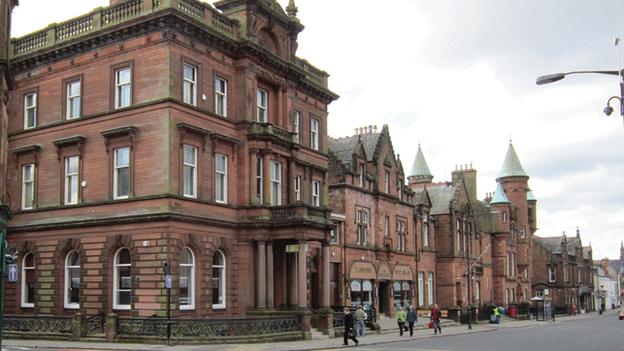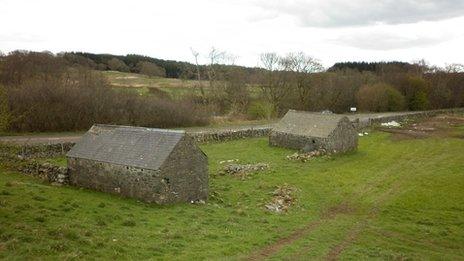Mary Timney: the last woman publicly hanged in Scotland
- Published

The last public hanging of a woman in Scotland took place on Buccleuch Street in Dumfries
"No, my lord, give me forever a prison - dinna, dinna do that!".
Mary Timney's plea for mercy as she was sentenced to death for the murder of Ann Hannah would be ignored.
Instead, on 29 April 1862, at Buccleuch Street in Dumfries, the 27-year-old mother became the last woman to be publicly executed in Scotland.
At a distance of 150 years, her story - and that of her victim - still make for terrible reading.
The sequence of events which led her to the gallows began on 13 January of the same year in the remote rural surroundings of Carsphad, near the eastern edge of what is now known as the Galloway Forest Park.
The police constable in New Galloway was summoned by Lockhart Hannah who had been called back to his home to find his sister lying in a "dying state" from "blows and other injuries she had received from some person or persons unknown".
Beside her body were a butcher's knife and a two-foot long piece of iron, both covered in blood.
Suspicion immediately fell on Mary Timney who lived next door and had "differed on several occasions" with the dead woman.
Investigations found witnesses who had seen Timney in the area with blood on her clothes and a wooden mallet in her hand.
She was subsequently charged with murder.
About three months later, Lord Deas presided over her trial in Dumfries. After hearing the evidence, it took a jury just half an hour to unanimously find her guilty of murder.
"The prisoner's face did not bleach in the least degree nor was her expression perceptibly altered," reported the Dumfries Standard.
"The dread words which thrilled the hearts of the onlookers seemed to have little influence upon her, whose destiny they determined.
"But when his lordship, in pronouncing sentence, addressed her, she fairly broke down and urgently and pathetically prayed for mercy at his hands."
Lord Deas told her she seemed to have taken offence when Ms Hannah had told her that regular loans of money were going to stop.
The dead woman had also accused Timney of stealing wood.
"Whatever these causes were, they were miserably small to have produced the result which they seem to have produced," the judge told Timney.
His closing words to her have a chilling ring.
"It only remains for me to pronounce upon you the last sentence of the law," he said.
"The time of all of us in this world is short.
"With most of us it is uncertain - in your case your days are numbered."
He then put on the black cap and sentenced her to be "hanged by the neck upon a gibbet till she be dead".

Mary Timney and Ann Hannah are thought to have lived in neighbouring properties like these in a remote part of Dumfries and Galloway
Following the verdict there were a number of attempts to stop the death penalty being enacted.
A meeting in Dumfries was convened to seek the "commutation of the sentence".
The Kirkcudbrightshire Advertiser reported that: "The great majority of the public of Dumfries were horrified and indignant that this butchery should be permitted in their streets."
They bemoaned the "brutalising tendency" of "legalised strangling".
The Dumfries Standard agreed: "A great change has come over the minds of the community with reference to the convict - and there is now a very general wish that her life may be spared."
MP for Dumfries William Ewart, a campaigner for the abolition of the death penalty, was urged to take the case to the Home Secretary of the day Sir George Grey.
More than 3,000 women signed a petition pleading for a change of heart and a deputation even went to visit Sir George at his home in north east England.
However, it was to no avail.
A letter on 24 April confirmed that he could not see "any ground which would justify" a reprieve. The execution took place five days later.
Some 200 special constables were sworn in to assist 50 policemen and local militia in dealing with the crowd.
The scaffold, "procured from Edinburgh", was erected at the junction of St David Street (now Irish Street) and Buccleuch Street and by 08:00 on Tuesday morning an estimated 3,000 people had gathered to witness the spectacle.
The executioner, William Calcraft, had arrived from London the day before.
"The clock on the New Church having struck eight, all eyes were turned to the scaffold," reported one newspaper.
"It had, however, been arranged that a quarter past eight was the hour at which the prisoner was to be launched into eternity, and those outside waited patiently for the scene."
At that time the executioner appeared dressed in "black clothes and a skull cap".
"Oh my four weans, oh my four weans, oh, oh, oh," Mary Timney was heard to cry.
But then her final moments were extended in a most bizarre manner.
A telegraph message was given to the prison governor who - "doubtless thinking it might be a reprieve" - tore it open.
However, he was "annoyed to find" it was from the Evening Herald newspaper in London "requesting the favour of a communication respecting the last moments of the unfortunate convict in time for the publication of the evening papers in the metropolis".
The grim scene then continued with Timney's last reported words "Oh dear" before she met her death.
"The crowd shortly afterwards dispersed, without noise or the slightest disturbance whatever," it was reported.
No woman would go through a public execution again in Scotland, although the practice continued for another six years elsewhere in Britain until the hanging of Frances Kidder in Maidstone in 1868.
It was not, however, the final chapter in Dumfries' own links with the practice.
The last man to be publicly hanged in Scotland, murderer Robert Smith, also met his end in the town in 1868.
His death mask can be viewed in Dumfries Museum to this day.
That same year, 1868, a law was passed that all executions should take place within prisons, but it would be another 100 years before the death penalty for murder was totally abolished.
They were changes which came too late for Mary Timney to be spared for taking her neighbour's life.
- Published4 August 2011
- Published4 August 2011
- Published2 August 2011